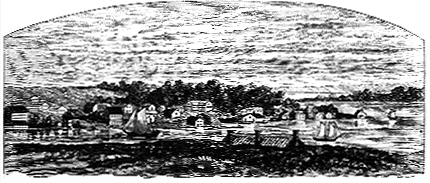
HISTORY OF BROOKLYN. 379
In the spring of this year, the Rev. Dr. John Henry Livingston, a distinguished scholar and member of the Reformed Dutch Church, established a theological school at the then village of Bedford, now embraced with the limits of Brooklyn. A Mr. Freligh, the first student licensed in Kings County, studied under him at the Cowenhoven house, west of Mr. Brevoort’s present dwelling, and boarded around among the neighbors. The school, however, was broken up in 1797.
1798. Rev. Dr. Jedediah Morse’s “American Gazetteer,” issued this year, thus briefly disposes of Brooklyn: “A township in Kings County, N. Y., on the west end of Long Island, having 1,603 inhabitants, and 224 are electors, by the State census of 1796. There are a Presbyterian church, a Dutch Reformed church, a powder magazine, and some elegant houses, which lie chiefly oil one street. East River, near a mile broad, separates the town from New York.”

VIEW OF BROOKLYN IN 1798
seen from the North). We take pleasure in presenting our readers with an interesting view, never before published, of the village of Brooklyn, as seen from a northerly point on New York Island, copied from a remarkably careful and evidently accurate sketch of New York City and Bay,
The family was a very disreputable one—the old man finally dying of wounds received in attempting, with his son Palmer, to commit a burglary upon the house of James W. Smith. Palmer, a giant in' stature, and possessing great courage and strength, was tile terror of the slender police force of the village at that day, and many anecdotes are told of his exploits. He was subsequently hung, in San Francisco, by the Vigilance Committee.